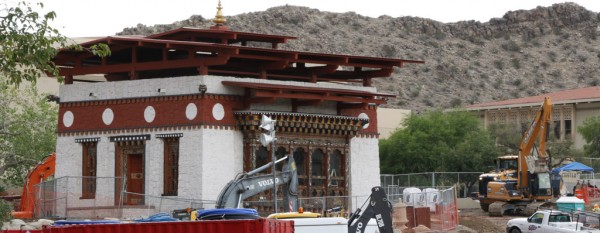
The temple was given to UTEP by the people of Bhutan after it was built for the Smithsonian Folklife Festival in Washington D.C. in 2008. Photo credit: Kate Gannon
EL PASO — Separation of church and state, unless we’re talking about a Buddhist temple at the University of Texas at El Paso? To celebrate its centennial, UTEP is undergoing a major physical transformation and a very visible part of the makeover is the placement on campus of a Lhakhang, or Buddhist temple.
The temple was given to UTEP by the people of Bhutan after it was built for the Smithsonian Folklife Festival that took place in Washington D.C. in 2008. It was later shipped to El Paso and kept in a warehouse until money was raised to place it on campus.
The Bhutanese architecture at UTEP is undeniably beautiful and so is Bhutan, it’s people and culture. But does that give UTEP the right to put a big temple in the middle of the new Centennial Plaza?
UTEP has crossed this line several times. Bhutan prayer flags outline the art museum, a Bhutan altar greets you in the library and, in November 2012, UTEP was host to former Buddhist monk Losang Samten who worked for four weeks in the Bhutan Cybercafe in the UTEP Union East building crafting a Kalachakra sand mandala.
Time-lapse video by Steve Osborne of Lobsang Samten and Kalacakra Mandala in El Paso
The sand mandala involves using sand to create artistic forms,. Accompanying ceremonies and viewings symbolize the Buddhist doctrinal belief in the transitory nature of material life.
According to Wikipedia, “The Kālacakra tradition revolves around the concept of time (kāla) and cycles (chakra): from the cycles of the planets, to the cycles of human breathing. It teaches the practice of working with the most subtle energies within one’s body on the path to enlightenment.”
These sand portraits feature deities within a complex structure and geometry. Although impressive, it is a religious tradition and its place in the heart of a public university campus should be questioned.
Losang Samten also showed onlookers how to meditate. This is a form of prayer and, in a country that outlaws prayer in public institutions. one wonders if that only applies to the ones praying to God.
So why was Samten allowed to teach people about the Bhutanese religion? This clearly crosses several lines in the church and state debate, so why is it being allowed? If the goal is to model the buildings after the beautiful architecture of Bhutan then what does a monk praying to his deities have to do with that?
In a 2011 interview with KVIA.com, UTEP’s Executive Vice President of Legal Affairs and Oversight Ricardo Adauto said, “UTEP’s ties to Bhutan are cultural, not religious.”
This claim that the structure is cultural and not religious seems to lack validity after the demonstration held in the Bhutan Cybercafe. Another interesting quote from from Aduato in the same interview is, “Nobody is asking (students and staff) to practice anything other than looking at the architecture.”
One wonders about the statements made by Aduato when a former Bhutanese monk spends four weeks on campus teaching people how to pray and what the religion of Bhutan consists of.
El Paso needs to ask why the lines that separate church and state continue to be crossed in a public institution. Building campus structures in a particular style is one thing, but a temple is something else.


quit whining, this is cultural and add beauty to the campus. Do you think students are going to go pray in the “temple” before a test?
Helen, I support separation of church and state. However, the issue here as I see it is truly about cultural exchange. Few UTEP students, faculty, or staff have the opportunity to visit Bhutan. Most importantly, as Mr. Adauto stated no one is asking people to pray or follow Bhutan’s religious traditions. When various monks have visited campus, I have only seen people pass by, stop for a few moments, and continue with their day. Admiring the skill required to create a Kalachakra and observing how one is made enriches UTEP’s cultural life.
Many universities have both a Baptist and/or a Catholic student union in this part of the country, people discuss abortion on campus (for many this topic is tied to religion), other topics of religion are discussed in myriad ways on campus.
Perhaps the most egregious crossing of the church/state line occurs when the clergy publicly comment on political candidates, for example, on television news shows. It seems to me we can only benefit from the cultural interchange that takes place between UTEP/El Paso and Bhutan.
Teaching ‘about’ a religion is not the same as promoting it. This principle has held up many times in church-state cases (which the author of this piece should have researched more carefully, rather than displaying her misunderstanding of the concept.) UTEP also has a religious studies program that teaches ‘about’ Islam, Catholicism, Bahai, Judaism… and none of those religions are being promoted either.
It’s too bad that the author of this poorly informed editorial chooses to view other cultures and religions as threats, rather than as opportunities for learning.
Querido amigo: Photography is all consuming. I have tried leaving it “cold turkey” but you recognize my weakness. They talk loudly and we love what they have to say. I hear your beautiful story.